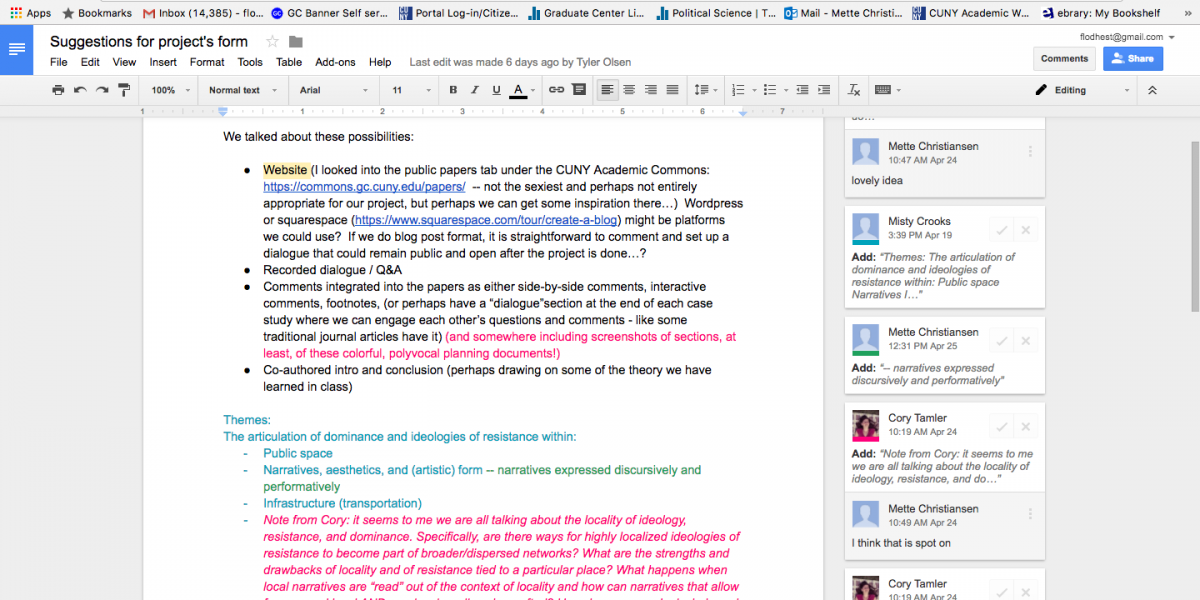¶ 1 Leave a comment on paragraph 1 0 This project was conceived and written by five authors. An experiment in public polyvocal scholarship, it is conceived as a platform that both contains/presents our research and embeds our collaborative process within it. As a result, it can be read in (at least) two ways: as an interdisciplinary collection of thematically linked case studies, and as a digital representation of a process of collaborative knowledge production. Readers should allow for a more pluralistic experience. Some group members worked more on some tasks while others focused on different sections. The goal is not a project meant to be taken in the same way as a solo research paper, but one that emphasizes the results of interaction over a cohesiveness that would have silenced anyone’s voice.
¶ 2 Leave a comment on paragraph 2 0 The order outlined below is one pathway you can take through the project. There are many other possibilities. We have included brief descriptions of each section below which you might use to choose your own route.
¶ 3 Leave a comment on paragraph 3 0 NOTES ON COMMENTS
¶ 4 Leave a comment on paragraph 4 0 In addition to writing individual case studies, each author has approached the entire group of case studies by taking up one loose theoretical thread and reading them through it. These individual theoretical threads can be followed in the comments. You can view comments in several ways and several formats:
- ¶ 5 Leave a comment on paragraph 5 1
- In-line with case studies: Navigate to individual case studies and interact with the “comments” pane on the right. This allows you to see all of the comments made by all of the authors on a given case study, side-by-side with the content of the case study. You can also click on a paragraph and you’ll be shown any comments associated with it. (Test it out! There’s an in-line comment on this paragraph you should be able to read to the right.)
- By commenter: This link allows you to separate out comments by the author of the comments and follow a single theoretical thread across the entire project.
- By case study: This link allows you to separate out comments by case study; the comments appear without the content of the case study alongside them. This view is useful for getting an overview of how several different authors have responded to the same case study.
¶ 6 Leave a comment on paragraph 6 0 RECOMMENDED ORDER FOR READING
¶ 7 Leave a comment on paragraph 7 0 Introductory Framing: Start here to get oriented to the common theoretical and conceptual themes.
¶ 8 Leave a comment on paragraph 8 0 Project Timeline and Development: This page gives an overview of the collaborative process and the evolution of the project from mid March to mid May. To access, go to Posts, All Posts. View posts all together for an overview. Click on individual posts for more detail.
¶ 9 Leave a comment on paragraph 9 0 Case Studies: These pages feature our individual work and research questions. We recommend reading them in the order below for maximum continuity.
- ¶ 10 Leave a comment on paragraph 10 0
- Spatial Discontents: Notes Towards a Praxis of Social Disalienation (by Mette Christiansen)
- Claiming Space, Transforming the State: The MST and Critical Pedagogy (by Tyler Olsen)
- The Right for Transportation (by Rafael Davis Portela)
- Moral Dissent and Inclusion: Activism and Political Access in North Carolina (by Misty Crooks)
- Simone Leigh: Performing the Private in Public (by Cory Tamler)
¶ 11 Leave a comment on paragraph 11 0 Comments: Each case study has been commented on by various group members. These are meant to tie together each person’s work while also emphasizing the benefits of working as a group. Please see our section, Notes on Comments, for more information on viewing comments.
¶ 12 Leave a comment on paragraph 12 0 Tying it Together: This is a less formally written set of ideas and final thoughts on our project. It can be read as the sort of comments made by a conference panel discussant.
¶ 13 Leave a comment on paragraph 13 0 Works Cited: This is a combined list of references as a way to illustrate the range of scholarship consulted for this project. It is not exhaustive. Other works are referenced within the comments.
¶ 14 Leave a comment on paragraph 14 0 Finally, while we have included our recommendations for reading, please feel free to peruse and play around as you wish. New insights can be gained from reading different pages alongside each other.

This is what an in-line comment looks like.